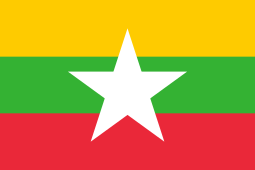Major dynasties have previously ruled the region that is now the nation of Burma. The Bagan Dynasty took control in 1044 A.D. This period is frequently referred to as Burma’s Golden Age. Buddhism started to take off as a major religion in Burma at this time. Many Buddhist shrines and pagodas were constructed by the kings of the Bagan Dynasty. Before the Mongol invaders arrived, this period lasted for around 150 years.
The Taungoo Dynasty emerged in the are,a as the following significant dynasty in 1486. The empire was expanded by this dynasty, which ruled for more over 250 years. After it came the Konbaung Dynasty. King Alaungpaya was the first ruler of the Konbaung people. This dynasty engaged in conflict with the Chinese, Siam, and eventually the British. In 1885 they were overrun by the British Empire. Burma joined British India at this point.
The Burmese desired independence from Britain after World War II. General Aung San served as their leader. January 1948 saw the independence of Burma. Although Burma initially had a constitutional government, there was a lot of struggle for dominance. Military authorities took charge. When the military group lost the elections in 1990, they refused to accept the outcome and put numerous political opponents in prison. Political figures who disagree with the military regime, including Augn San Suu Kyi, are still imprisoned today.
| Capital | Rangoon (Yangon) |
| Population | 54,652,953 (Source: 2023 worldometer) |
| Major Cities | Naypyidaw, Yangon, Mawlamyine, Bago, Mandalay, Pathein, Monywa, Myeik, Meiktila |
| Borders | Bangladesh and India to its northwest, China to its northeast, Laos and Thailand to its east and southeast, and the Andaman Sea and the Bay of Bengal to its south and southwest. |
| Gross Domestic Product (GDP) | $59,364,362,541 (2022 worldometer) |
| Currency | kyat (MMK) |

Burma (Myanmar) Major Industries: agricultural processing; knit and woven apparel; wood and wood products; copper, tin, tungsten, iron; construction materials; pharmaceuticals; fertilizer; cement; natural gas
Burma (Myanmar) Agricultural Products: rice, pulses, beans, sesame, groundnuts, sugarcane; hardwood; fish and fish products
Burma (Myanmar) Natural Resources: petroleum, timber, tin, antimony, zinc, copper, tungsten, lead, coal, some marble, limestone, precious stones, natural gas, hydropower
Burma (Myanmar) Major Exports: clothing, gas, wood products, pulses, beans, fish, rice
Burma (Myanmar) Major Imports: fabric, petroleum products, plastics, machinery, transport equipment, construction materials, crude oil; food products
Total Size of Burma (Myanmar): 676,578 km² (source: wikipedia)
Geographical Low Point of Burma (Myanmar): Andaman Sea 0 m
Geographical High Point of Burma (Myanmar): Hkakabo Razi 5,881 m
Climate of Burma (Myanmar): Tropical monsoon; cloudy, rainy, hot, humid summers (southwest monsoon, June to September); less cloudy, scant rainfall, mild temperatures, lower humidity during winter (northeast monsoon, December to April)
General Terrain of Burma (Myanmar): central lowlands ringed by steep, rugged highlands
World Region or Continent of Burma (Myanmar): Southeast Asia
Geographical Coordinates: 22 00 N, 98 00 E
Burma (Myanmar) Government Type: military junta
Burma (Myanmar) Nationality: Burmese (singular and plural)
Burma (Myanmar) National Holiday: Independence Day, 4 January (1948); Union Day, 12 February (1947)
Burma (Myanmar) Independence: 4 January 1948 (from UK)
Burma (Myanmar) National Symbol: chinthe (mythical lion)
Burma (Myanmar) National Anthem or Song: chinthe (mythical lion)
Burma (Myanmar) Languages Spoken: Burmese, minority ethnic groups have their own languages
Burma (Myanmar) Religions: Buddhist 89%, Christian 4% (Baptist 3%, Roman Catholic 1%), Muslim 4%, animist 1%, other 2%
Southeast Asian nation Myanmar, usually referred to as Burma, is situated there.
The main city in Myanmar is Yangon (formerly known as Rangoon), whereas Naypyidaw is its capital.
With a total area of nearly 676,000 square kilometers (261,000 square miles), Myanmar is the largest nation in all of mainland Southeast Asia.
Bangladesh, India, China, Laos, and Thailand all border the nation.
More than 54 million people call Myanmar home, with the Bamar (Burmese) ethnic group making up the majority.
Burmese is the official language of Myanmar, and Buddhism, which predominates there, has a big impact on the culture of the nation.
With historical monuments like the ancient city of Bagan, which is home to hundreds of temples and pagodas, Myanmar has a rich cultural heritage.
One of Myanmar’s most revered Buddhist sites, the Shwedagon Pagoda in Yangon is decorated with gold and priceless stones.
Myanmar is renowned for its varied and tasty food, which includes dishes like curries, tea leaf salads, and the well-known rice noodle soup mohinga.
One of the main waterways in the nation, the Irrawaddy (Ayeyarwady) River, is crucial for travel, agriculture, and tourism.
A tropical monsoon climate, with distinct wet and dry seasons, prevails in Myanmar.
The nation is home to a wide variety of animals, such as elephants, tigers, leopards, and other bird species.
The Shan State’s Inle Lake is renowned for its distinctive floating gardens, stilt-house communities, and leg-rowing fisherman.
There are numerous ethnic minorities in Myanmar, and each one has its own unique customs, dialects, and cultural practices.
The nation has a difficult political past and just experienced a democratic transition.
Lacquerware, weaving, and elaborate woodcarvings are all examples of Myanmar’s traditional art.
In Myanmar, thanaka, a paste produced from finely crushed tree bark, is frequently used as a traditional cosmetic and sunscreen for the face.
The Burmese Kyat (MMK) is the nation’s official currency.
Mountains, woods, rivers, and stunning beaches border Myanmar’s shoreline, making for a broad spectrum of natural settings.
Numerous national parks and protected areas throughout the nation, including Hlawga National Park and Alaungdaw Kathapa National Park, are home to a variety of wildlife species.

